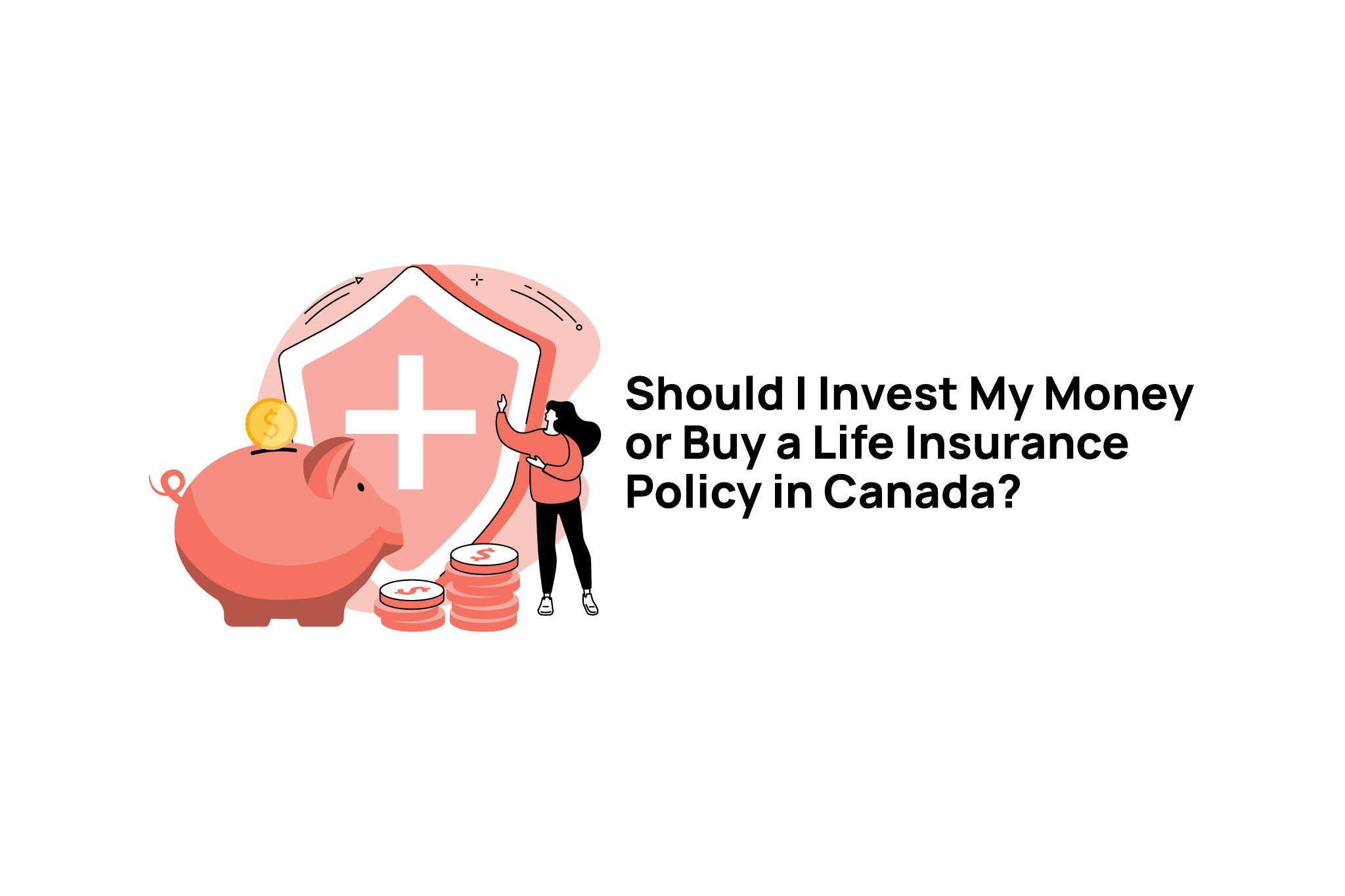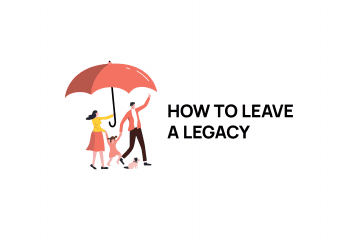Do you often wonder where to funnel your hard-earned money to secure your financial future? If you answer yes, you’re not alone. In fact, the question, “Should I invest my money or buy life insurance in Canada” keeps many up at night as they strive to manage today’s dreams with tomorrow’s uncertainties.
As a Canadian, your financial planning for the future may involve leveraging investment tools such as Tax-Free Savings Accounts (TFSAs), Registered Retirement Savings Plans (RRSPs), or life insurance policies. If you’re a young professional eyeing early retirement, TFSAs and RRSPs may present an opportunity to build wealth over time.
Meanwhile, families and retirees in Canada may prefer the security that comes with life insurance, which protects their loved ones financially in case of unexpected events. If you’re at the crossroads of the best investment options vs. life insurance in Canada, don’t worry.
In this piece, we’ll discuss how each option fits different life stages and financial goals, as well as the benefits and risks involved. Ultimately, you’ll be able to choose what strategy might work best for you.
Investing in Canada: What You Need to Know
Investing in Canada involves channeling your money into assets that can yield returns over time. According to the Canadian government’s official website, the nation has led the G7 countries in economic growth for over a decade, which indicates that the country offers possible investment opportunities for its citizens.
Yet, despite Canada’s $2.5 trillion economy, knowing where to invest can be challenging but can make a huge difference in achieving your financial goals quickly.
Here are a few options you can invest in to earn an attractive yield:
- Stocks and ETFs: You can own a share of Canadian giants like Shopify or TD Bank. You can also invest in some of the best ETFs (Exchange-Traded Funds), such as Vanguard FTSE Canada All Cap Index and Vanguard FTSE Canada Index.
- Bonds: These are another great long-term investment option, where you can lend funds to the government or large corporations and earn returns. According to the Bank of Canada, government bonds yield ~3.1% over ten years, offering steady, low-risk passive earnings.
- Real Estate: Canadian real estate is estimated to reach $8.80 trillion in 2025; investment in this sector is ripe. As such, you can invest in Real Estate Investment Trusts (REITs), where you own offices, apartment buildings, and shopping centers.
Canadians can also benefit from other investment options such as Tax-Free Savings Accounts (TFSAs), Registered Retirement Savings Plans (RRSPs), and non-registered accounts.
TFSAs allow lifetime financial growth, making them popular among young families or Canadians over eighteen. Contributions to this account are not tax-deductible, and all income earned (interest, dividends, capital gains) is tax-free.
RRSPs are government-registered accounts designed to help Canadians save for retirement. Contributions here are tax-deductible, reducing your taxable income in the year you contribute. They help build long-term retirement savings via tax-deferred contributions.
Non-registered accounts are investment accounts not registered with the Canadian government. Banks or financial providers offer this investment option, which is taxable. However, it’s flexible (in terms of investments and withdrawals) and has no contribution limits.
Pros and Cons of Investing in Canada
Despite opportunities and fund diversification options, investing in Canada isn’t all sunshine. It’s a strategic game with highs and lows. First, let’s discuss the pros:
- High Growth Potential: The Canadian stock market index (S&P/TSX Composite Index) has averaged a 5% annual return over 10 years, indicating significant yearly investment growth.
- Tax Advantages: TFSAs allow tax-free withdrawals, while RRSP contributions lower taxable income and defer taxes.
- Diverse Opportunities: Investors can diversify their funds into various Canadian industries, from energy and finance to tech and healthcare.
- Stable Economy: Canada ranks among the best countries for business, with a strong banking system and low corporate taxes.
Here are a few downsides to investing in Canada:
- Market Volatility: The Canadian stock market has seen significant crashes, dropping over 30% in 2008 (the global financial crisis) and 2020 (the COVID-19 pandemic).
- No Investment Guarantees: Stocks carry risks, with companies like Nortel wiping out shareholders.
- Adequate Knowledge and Time Commitment: Investing in Canada requires sufficient knowledge, in-depth research, and time to manage such investments.
Life Insurance in Canada: Is it a Better Option?
Before giving a final nod to this question, “Should I invest my money or buy life insurance in Canada” let’s see if life insurance is a better option. Many believe that opting for this strategy means preparing for the worst. However, it’s about giving your loved ones peace of mind in the future.
Who needs life insurance?
- Parents: It replaces lost income plus covers childcare costs if you’re gone.
- Homeowners: It ensures your family keeps the house if mortgage debt remains.
- Business Owners: Life insurance could fund buy-sell agreements or protect partners.
- Individuals with Significant Estates: It could provide financial security for beneficiaries of an estate by covering probate fees, funeral expenses, and any outstanding debt that could affect the property’s value.
Once you assess your needs, the next logical step is to determine the best type of life insurance to apply for.
The main types are term, whole, and universal life insurance.
- Term Life Insurance
Term life insurance is an affordable temporary coverage (for 10-30 years), ideal for covering mortgages or funding your child’s education.
According to the Canadian Life and Health Insurance Association (CLHIA) data, Canadians have over $5.5 trillion in life insurance, with 75% in term life. It’s best for young families or professionals with time-limited financial obligations.
- Whole Life Insurance
This is lifetime coverage plus a cash value component that grows tax-deferred. It can serve as a savings account for Canadian families. Premiums can range from CAD 200 to CAD 500 per month. This option is excellent for high-net-worth individuals seeking a tax-free wealth transfer.
- Universal Life Insurance
This option offers flexible permanent coverage with investment-linked growth. You can adjust premiums and death benefits as your needs change. Although the costs are higher, this option is excellent for entrepreneurs or Canadians who want to blend insurance with stock market investment.
The table below provides an overview of universal life vs. term life vs. whole life insurance in Canada.
| Features | Term life insurance | Whole life insurance | Universal life insurance |
| Primary purpose | Temporary coverage (e.g., 10–30 years) | Lifelong coverage and guaranteed cash value | Flexible lifelong coverage and investment options |
| Coverage duration | Fixed term (10, 20, 30 years) | Permanent (lasts until death) | Permanent (lasts until death) |
| Premiums | Lowest initial cost; may increase upon renewal | Fixed premiums | Flexible premiums |
| Death benefits | Tax-free payouts to beneficiaries | Tax-free payouts to beneficiaries | Tax-free payouts to beneficiaries |
| Cost | Most affordable in the short term | Highest cost (covers lifelong + cash value) | Mid-to-high cost (depends on investment choices). |
Pros and Cons of Life Insurance in Canada
So, is life insurance a better option than investing in Canada? Let’s weigh the benefits against the costs.
Here are the pros:
- Financial Safety Net: Life insurance provides income replacement, ensuring dependents maintain their standard of living.
- Tax-Free Death Benefits: Payouts go to beneficiaries tax-free. This helps avoid probate fees in provinces like Ontario.
- Cash Value Growth: Whole and universal life policies build savings that can be borrowed for major expenses, such as funding a child’s wedding or a business venture.
The cons:
- High Costs: Some types of life insurance (like whole life) are significantly more expensive than traditional investments in Canada.
- Lower Returns: Cash value growth is slower than investing in stocks or ETFs over time.
- Unnecessary for Some: Single individuals or retirees without dependents may not need coverage.
So, what’s the bottom line? Life insurance isn’t a one-size-fits-all answer. For young families, term life offers affordable protection. For retirees, whole life can simplify estate planning and transfers for beneficiaries.
Get a free quote
RRSP vs. Life Insurance
When planning for the future, Canadians may want to choose between Registered Retirement Savings Plans (RRSPs) and permanent life insurance. The table below highlights their differences.
| Feature | RRSP | Life Insurance |
| Primary Purpose | Retirement savings with tax deferral | Lifelong protection + cash value growth |
| Tax Treatment | Contributions are tax-deductible; withdrawals are taxed as income | Premiums are not tax-deductible; death benefits are tax-free. Cash value grows tax-deferred |
| Contribution Limits | Capped annually (18% of prior income) | No legal limits; policy terms determine premiums |
| Investment Growth | Market-dependent returns | Potential dividends |
TFSA Investment vs. Insurance: Examining Their Differences
What about TFSA investment vs. insurance? Let’s explore their distinct features in the table below:
| Feature | TFSA | Life Insurance |
| Primary Purpose | Tax-free savings for flexible goals | Lifelong protection + cash value growth |
| Tax Treatment | Contributions are after-tax; growth/withdrawals are tax-free | Premiums aren’t tax-deductible; death benefits are tax-free. Cash value grows tax-deferred |
| Access to Funds | Withdraw anytime, tax-free | Borrow or withdraw cash value tax-efficiently |
| Investment Options | Stocks, bonds, ETFs.) | Insurer-managed cash value and potential dividends |
| Market Risk | Subject to market fluctuations | Guaranteed growth; insulated from the market’s volatility |
4 Key Factors to Consider Before Choosing
Deciding between investing vs life insurance in Canada isn’t just about which option is right or wrong. It’s vital to assess your life and goals carefully.
Here are four factors to consider before investing funds or insuring your future.
- Financial Goals
If you’re a young professional chasing early retirement or house ownership in Alberta or Ontario, wealth creation could be your main objective. Therefore, you should consider investing in TFSAs/RRSPs or low-fee ETFs to compound your savings.
Conversely, if you prefer financial security and stability, especially for your dependents, life insurance could offer the protection you need to secure your family’s future. So, as you weigh these decisions, ask yourself: “Do I want my money working for me now or protecting my loved ones later?”
- Risk Tolerance
Next, you want to assess your risk tolerance. Investments might work well for you if you’re comfortable with the stock market’s volatility. However, if the thought of “the stock market could crash tomorrow” keeps you awake at night and constantly checking your portfolio, it might be time to lean toward life insurance’s steadiness.
- Dependents
Dependents are another crucial factor to consider. Citizens with little or no family obligations could skip life insurance and opt for aggressive investment strategies. Meanwhile, a comprehensive life insurance policy could benefit those with young children or relatives.
- Time Horizon
Finally, evaluate when you need the money. Are you saving for a short-term goal, such as a home? A TFSA, with its tax-free advantages, could be useful.
Are you thinking long-term, such as funding your children’s education or retirement? While RRSPs offer tax breaks now, life insurance shields you and your loved ones later.
As you carefully assess these factors, these scenarios may offer some perspective:
- Young Professional (No Dependents): Invest aggressively in ETFs and skip life insurance for now.
- Parent (Aged 35-50): Blend term life insurance with RESP/TFSA contributions.
- Retiree: Use whole life to cover final expenses + leave tax-free wealth to grandkids.
These are hypothetical situations that don’t factor in real-life circumstances and conditions. However, they can help you plan your finances better.
Can You Do Both? The Balanced Approach
Sometimes, trying both options is the best way to settle the life insurance vs. investment debate in Canada. Yes, you can harness the benefits of wealth creation now while providing financial stability for you and yours later.
Here’s an example of how Canadians can benefit from protection and growth in the long term: Start with term life insurance, which offers affordable and straightforward coverage for your family’s financial security. You can check our coverage calculator on our official website to determine how much life insurance could cost you depending on your age, province, and term length.
Then, invest your savings in a TFSA or RRSP. These accounts allow you to build wealth over time via tax-advantaged Canadian investment strategies. They complement your insurance plan by supporting long-term financial goals and compounding growth.
If you want to combine investment and protection in one convenient package, universal life insurance offers a blend of the two. One significant aspect to watch out for is its typically lower returns than pure investment options.
Get a free quote
Conclusion: Which Option Is Right For You?
There you go! The life insurance vs. investment debate in Canada may seem puzzling at first. However, your ultimate choice profoundly reflects what you value more: protecting the present or nurturing the future.
From our discussions, we learned that investing in Canada can help create wealth for younger citizens with few dependents. Meanwhile, life insurance offers peace of mind, ensuring your loved ones are protected and guaranteed the maximum amount in any unexpected event.
If you’re young and financially independent, prioritizing investments like TFSAs and RRSPs can set you up for success. However, if a family relies on you, securing a term life policy first and investing your savings creates a balanced strategy.
Not sure where to start? A trusted financial advisor can help select the best Canadian investment strategies that fit you best. When it’s time to explore life insurance options, don’t hesitate to reach out to us. Our expert team will assist you in figuring out how much coverage you need and the policy that fits you best.
Frequently Asked Questions (FAQs)
- Can I use life insurance as an investment in Canada?
Yes, whole life and universal life insurance policies have investment components, but their returns are typically lower than stocks or ETFs.
- Is it better to invest in a TFSA or buy life insurance?
If your goal is wealth creation, a TFSA is better because it offers tax-free growth. However, if you want financial protection, life insurance is a better choice.
- What type of life insurance is best for Canadians?
For most Canadians, term life insurance is the best option because it’s affordable and provides essential coverage without high costs.
- Should I invest or buy life insurance first?
If you have dependents, prioritize life insurance first. If not, investing early helps grow wealth over time.
- Can I combine life insurance and investing in Canada?
Absolutely! Many Canadians choose term life insurance for protection and invest separately in a TFSA, RRSP, or non-registered accounts for growth.




